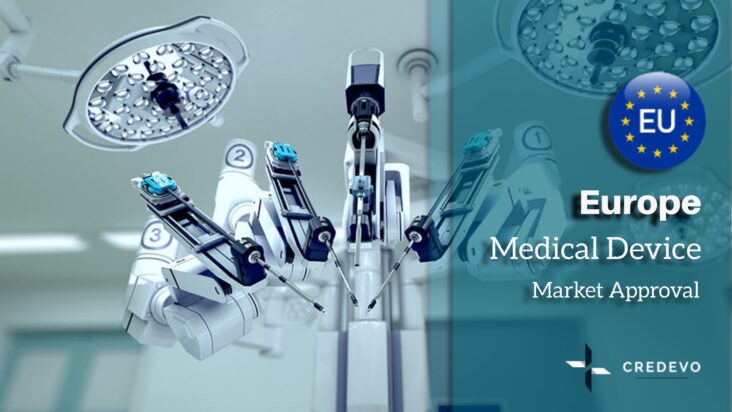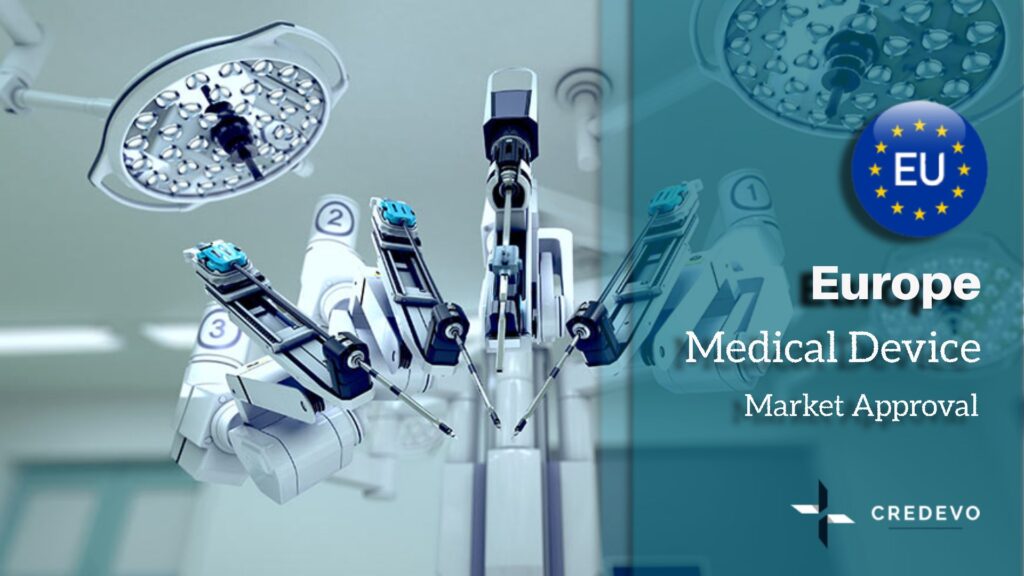Europe: Medical Device Market Approval

The European medical device market represents about 30% of the global market, after the U.S. market with a 42% share. The rising geriatric population, an increasing number of surgical procedures (especially orthopedic), and the availability of funding for research and innovation are some of the driving factors for the growth of the medical device market in Europe.

According to a report, the projected revenue in the European Medical Devices market is expected to reach US$136.30 billion in 2023.
Orthopedic device segment
The growing incidence of orthopedic disorders such as osteoporosis, arthritis, soft-tissue injuries, and fractures among the elderly population, and the high adoption of simulation techniques in laparoscopy and technological innovations are the factors responsible for the large percentage of this segment.
Following this segment, other potential segments include cardiology devices, diagnostic imaging devices, orthopedic devices, ophthalmology devices, endoscopy devices, and diabetes care devices.
Europe’s medical device regulatory
The EMA (European Medical Agency) is responsible for evaluating the quality, safety, and efficacy of marketing authorization applications assessed through the centralized procedure, including the safety and performance of the medical device concerning its use with the medicinal product.
Medical devices within the EU are currently regulated by 3 Directives:
- Council Directive 90/385/EEC on Active Implantable Medical Devices (AIMDD) (1990)
- Council Directive 93/42/EEC on Medical Devices (MDD) (1993)
- Directive 98/79/EC of the European Parliament and of the Council on in vitro Diagnostic Medical Devices (IVDMD).
New regulations
With the priority to ensure a robust, transparent, and sustainable regulatory framework and maintain a high level of safety while supporting innovation, the EU has revised the laws governing medical devices and in-vitro diagnostics.
On 23 April 2020, the Council and the Parliament adopted Regulation 2020/561 amending Regulation (EU) 2017/745 on medical devices regarding application dates and its provisions. These enter into force on the day of its publication in the official journal of the European Union.
- Medical Devices – Regulation (EU) 2017/745 of the European Parliament and of the Council of 5 April 2017.
- In Vitro diagnostic medical devices – Regulation (EU) 2017/746 of the European Parliament and of the Council of 5 April 2017 on
- Regulation 2020/561 of the European Parliament and of the Council of 23 April 2020
Before registering any medical device in Europe, you need to be aware of three key things.
- CE (Conformité Européenne) marking.
- Authorized Representative (AR) in Europe & Responsible Person (RP).
- Different types of devices.
CE (Conformité Européenne) marking
Medical devices in the EU have to undergo a conformity assessment to demonstrate that they meet legal requirements to ensure they are safe and perform as intended.
- CE marking is only obligatory for products for which EU specifications exist and require the affixing of CE marking.
- Manufacturers can place a CE (Conformité Européenne) mark on a medical device once it has passed a conformity assessment.
The EU Member States can designate accredited notified bodies to conduct conformity assessments.
The conformity assessment usually involves
- A technical dossier documenting conformity
- Determining whether you can assess your product by yourself or if you have to involve a notified body
- Drafting and signing an EU declaration of conformity
Authorized Representative (AR) in Europe & Responsible Person (RP)
The role of an Authorized Representative (AR) in Europe and a Responsible Person (RP) in the UK for medical device registration involves acting as a liaison between the medical device manufacturer, the Competent Authorities, and, where applicable, the notified bodies. Here’s a brief overview of their roles:
Authorized Representative (AR) in Europe
- The AR is a legal entity appointed by a non-European manufacturer to represent them in dealings with European authorities.
- The AR must be established within the European Union (EU) or the European Economic Area (EEA).
- Responsibilities include assisting with regulatory compliance, maintaining technical documentation, and serving as a point of contact for communication with Competent Authorities.
Responsible Person (RP) in the UK
- The Responsible Person is a role specific to the UK under the UKCA (UK Conformity Assessed) marking system, which is separate from the EU regulatory framework.
- Similar to the AR, the RP ensures that the medical devices comply with UK regulations.
- The RP must be established in the UK and take responsibility for aspects such as registering the device, maintaining technical documentation, and ensuring post-market surveillance.
What are the different types of devices?
- Medical devices (MDs)
- Medical devices are products, services, or solutions that prevent, diagnose, monitor, treat, and care for human beings by physical means.
- Some examples of medical devices are sticking plasters, contact lenses, X-ray machines, pacemakers, breast implants, software apps, and hip replacements.
- In-vitro diagnostics (IVDs)
- In-vitro diagnostics are non-invasive tests used on biological samples (for example blood, urine, or tissues) to determine the status of one’s health.
- Some examples include HIV blood tests, pregnancy tests, and blood sugar monitoring systems for diabetics.
- Digital health and care refers to tools and services that use Information and Communication Technologies (ICTs) to improve prevention, diagnosis, treatment, monitoring, and management of health and lifestyle.
Regulations for various devices in Europe
Medical devices
Medical devices are classified into 4 classes following a risk-based classification system
Classification of a medical device in Europe
| S No | Class | Examples |
| 1 | Class I (Non-sterile, Non-Measuring) | Corrective glasses |
| 1 | Class I (Sterile, measuring) | Simple bandages or wound care products |
| 2 | Class IIa | Syringes for pump infusion |
| 3 | Class IIb | Anesthesia machines |
| 4 | Class III | Stents |
The approval process for medical devices in Europe
- A foreign manufacturer needs to appoint a local representative
- The sponsor should determine, which category the device belongs to
- If the device belongs to class I, non-sterile, and non-measuring, then a QMS is not formally required. However, a PMS procedure is required though not audited by a Notified Body (NB)
- For those devices that belong to other classes, a Quality Management System (QMS) is required, and most companies apply for ISO 13485 standard to achieve QMS compliance
- The applicant shall prepare a technical file and demonstrate compliance. In the case of the class III device, a dossier has to be compiled
- The QMS and the technical file (dossier in case of class III device) shall be audited by a notified body. For class I, non-sterile, and non-measuring, there is an audit or technical file required
- Prepare a declaration of conformity
IVD devices
IVDs (In-vitro diagnostic devices) are classified into 4 classes following a risk-based classification system
Classification of IVD devices in Europe
| S No | Class | Examples |
| 1 | List A | ABO blood typing |
| 2 | List B | Blood glucose monitoring |
| 3 | Devices for self-testing | Pregnancy tests |
| 4 | Self-declared devices | Clinical chemistry analyzer |
The approval process for IVD devices
- A foreign manufacturer needs to appoint a local representative
- The sponsor should determine, which category the IVD device belongs to
- Sponsor shall implement the QMS system (the QMS does not require certification from a registrar for general IVD self-certified devices),
- For other classes of IVD devices, the Quality Management System (QMS) is required and most companies apply for ISO 13485 standards to achieve QMS compliance
- The sponsor shall prepare a technical file and demonstrate compliance. In the case of the List-A IVD device, a dossier has to be compiled.
- The QMS and the technical file (dossier in case of list A IVD device) shall be audited by a notified body. For general IVD self-certified devices, no audit or technical file is required.
- Prepare a declaration of conformity
Along with these devices, some other devices come under the regulatory as below
Medicinal products that include a medical device (Combination products)
Some medicines are used in combination with a medical device, usually to enable the delivery of the medicine or improve the performance.
If the principal intended action of the combination product is achieved by the medicine, the entire product is regulated as a medicinal product
There are two types of combination
- Integral: the medicinal product and device form a single integrated product e.g. prefilled syringes and pens, patches for transdermal drug delivery, and pre-filled inhalers;
- Co-packaged: the medicinal product and the device are separate items contained in the same pack e.g. reusable pen for insulin cartridges, tablet delivery system with controller for pain management.
Medical devices that are co-packaged or obtained separately must be CE-marked following the medical device legislation.
Medical devices with an ancillary medicinal substance
A medical device may contain an ancillary medicinal substance to support the proper functioning of the device. These products fall under the medical devices legislation and must be CE-marked.
Examples of medical devices with an ancillary medicinal substance include
- Drug-eluting stents,
- Bone cement containing an antibiotic, and
- Catheters coated with heparin or an antibiotic agent.
Looking for regulatory support for your medical device in Europe
Talk to us today. Provide preliminary details below and we will help you achieve a successful registration in EUROPE. Credevo can be your strategic partner to make a successful submission in a timely manner. You will get a complete overview of the regulatory framework, process overview, and timelines associated with submissions.